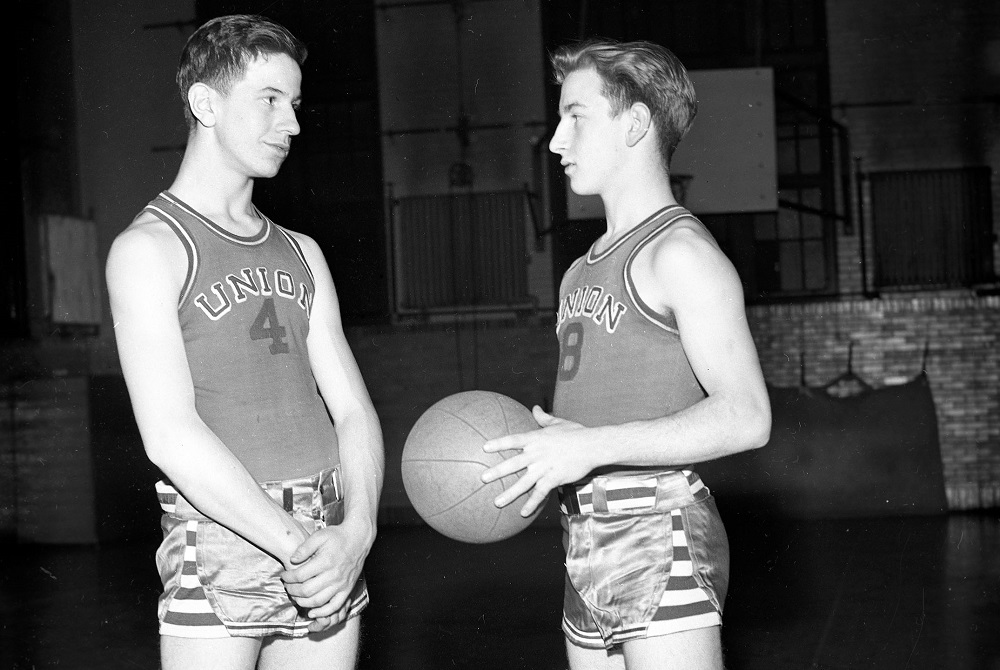
Longtime Coach Researches Photos to Tell Story of Grand Rapids Sports' Past
By
Steve Vedder
Special for MHSAA.com
September 16, 2022
GRAND RAPIDS – Bob Schichtel always pauses when he comes across the ancient black and white photo long enough to ponder whatever became of the two youngsters adorned in Grand Rapids Union basketball uniforms.
The posed shot shows two players facing each other in a local gymnasium in a photo apparently taken four days after the Japanese surprise attack on Pearl Harbor in 1941 that launched the country into World War II. Only a handful of fans today would recognize the players' striped, ultra-short shots and simple sleeveless shirts with "Union" emblazed across the front as recognizable basketball uniforms. One holds a battered-looking basketball, while the other looks on. The two players, whose uniform numbers are "4" and "9," aren't really smiling, but still seem as close as any teammates, whether 81 years ago or today.
In fact, it's the look the youngsters share that intrigues Schichtel, whose thankless, pro bono job it is to identify the two players.
"Once you start," said Schichtel, a former longtime Grand Rapids basketball coach, "it's like looking down a deep rabbit hole."
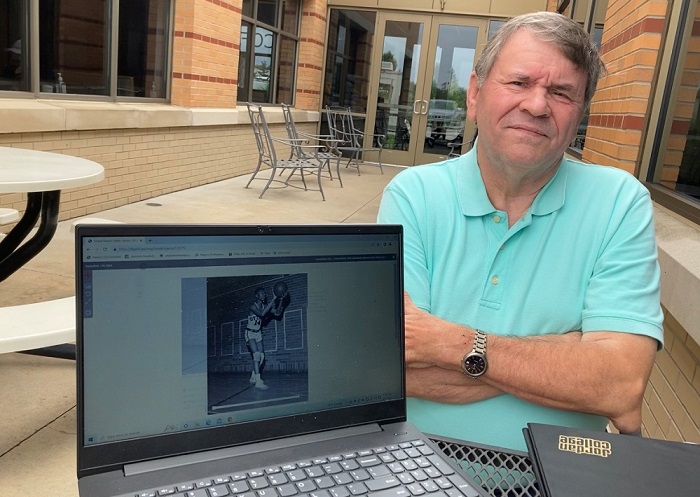 Schichtel works as a volunteer for the Grand Rapids Public Library trying to identify mostly former Grand Rapids City League basketball players from approximately 1938 through the early fifties. The online photos are mostly from the Robinson Photo Studio Collection taken in conjunction with the Grand Rapids Herald newspaper. The library says the unique collection spans some 950 basketball negatives from the entire Robinson/Herald collection that totals well over 900,000 Grand Rapids photos.
Schichtel works as a volunteer for the Grand Rapids Public Library trying to identify mostly former Grand Rapids City League basketball players from approximately 1938 through the early fifties. The online photos are mostly from the Robinson Photo Studio Collection taken in conjunction with the Grand Rapids Herald newspaper. The library says the unique collection spans some 950 basketball negatives from the entire Robinson/Herald collection that totals well over 900,000 Grand Rapids photos.
While the work – which amounts to a ton of patience combined with a detective ability – can be exhausting, it's still what Schichtel describes as a labor of love. For example, there's the shot of the two still-unidentified Union players. Schichtel looks at the photo and can't help but wonder whatever happened to the kids. Were they exceptional athletes? Did they leave their marks on Grand Rapids history, whether it was in education, politics, business, industry, the arts or another field? He doesn't even know, as in many photos from this era, whether the two entered the military and thus even survived World War II.
Schichtel has searched everywhere for the answers, but has come up short. Too many times, in fact.
Which isn't to say he'll quit looking or chalk up his research as inconsequential. Schichtel said the foremost reason he spends hours on the project is that many of the athletes he identifies deserve the recognition for achievements far beyond basketball. In many cases former City League basketball, football, baseball, track and tennis athletes became the foundation on which Grand Rapids was built. If Schichtel can uncover an old photo which depicts these youngsters during their high school careers, so much the better, he said.
"It's important to recognize Grand Rapids sports history, and I don't know if we've given enough attention to their past," Schichtel said. "They are what got us here, and I'm a firm believer they need to be recognized for it."
Figuring out that history, however, ranges from, at the least, extremely time consuming to – in too many frustrating cases – virtually impossible. The City League was formed in the late 1920s and featured original schools Grand Rapids Central, Creston, South, Union, Ottawa Hills, Catholic Central and Davis Tech. The league was eventually folded into the Ottawa-Kent Conference in 2008.
"It was a long, evolving league," Schichtel said.
 The identification tools available to Schichtel are actually more numerous than most would suspect. For starters, he's formed an impressive database of information by pouring through old City League yearbooks and programs, photos from other collections and microfilm of old newspapers, And then there's also the knowledge gathered by Schichtel himself, a 1968 Grand Rapids Catholic Central graduate. After playing in many old City League gymnasiums, Schichtel went on to compile a 389-197 record in 27 years as the Cougars girls basketball coach. He uses countless City League contacts as both a player and coach to identify athletes. In all, Schichtel taught in the Grand Rapids school system for 34 years.
The identification tools available to Schichtel are actually more numerous than most would suspect. For starters, he's formed an impressive database of information by pouring through old City League yearbooks and programs, photos from other collections and microfilm of old newspapers, And then there's also the knowledge gathered by Schichtel himself, a 1968 Grand Rapids Catholic Central graduate. After playing in many old City League gymnasiums, Schichtel went on to compile a 389-197 record in 27 years as the Cougars girls basketball coach. He uses countless City League contacts as both a player and coach to identify athletes. In all, Schichtel taught in the Grand Rapids school system for 34 years.
He also uses the game itself to identify the photos. For instance, he can pinpoint some photos simply by the styles of the uniforms worn by players. He also figures out who is who by other clues such as what the players are doing in the photo. If a player is taking a set shot in the photo, it's likely pre-World War II. The beginnings of the jump shot, or what Schichtel calls "elevation while shooting," is probably mid-1940s. In addition, Schichtel can identify photos through pure basketball athleticism. Players can look a bit awkward in shots from the thirties as compared to players from the late 1940s who were beginning to play with a more obvious flare.
Put all the information together and Schichtel, who has uncovered more than two dozen personal connections to subjects in the photos, believes he has a reasonable shot at identifying them.
Since he signed on with the project, Schichtel figures he's identified about 10 percent of the photos he's viewed. Among the City League athletes he's found shots of Central's John Lavan, who was born in 1890 and played Major League Baseball during the Babe Ruth era and became a military hero who is buried in Arlington National Cemetery; Creston basketball player Roger Wilkins, an assistant United States attorney general during the Watergate hearings; Art Spoelstra of Godwin, a former NBA player and member of the Grand Rapids Hall of Fame; and Grand Rapids native Bill Cutler, who turned a chance post-World War II meeting with then-American League president Will Harridge into a position as commissioner of the Pacific Coast League,
Schichtel said gaining information through photos on the people who became the bedrock of Grand Rapids should be celebrated.
"I think it's a great approach for the community; they shouldn't be forgotten," Schichtel said. "Who else is going to do this? Why do I do it? I see a certain, for lack of a better word, a nobility. These kids played for the love of game, and they became the “Greatest Generation.” These kids did great things. It's not just, 'Well, there's No. 58,’ in a photo.
"You want to know more about them. That's the real intrigue for me."
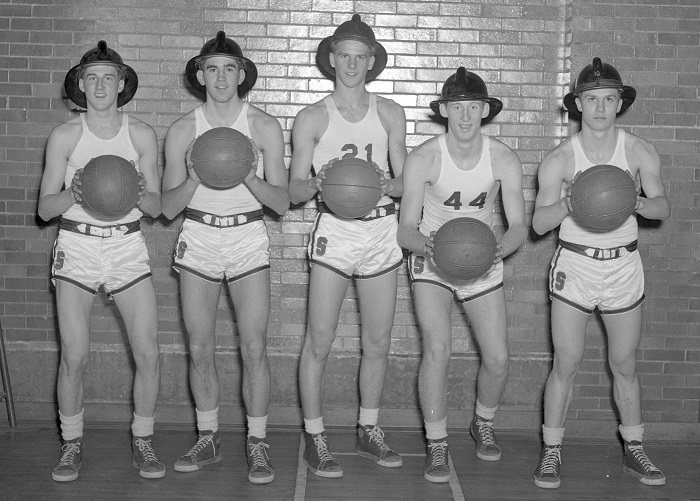 Tim Gloege of the Grand Rapids Public Library said the collection of photos – and their identification – is continually growing. As more people log onto the library's website, more people want to either add to the collection or have information that leads to an identification. The library estimates about 1,200 photos are searched monthly. But as time grows, many of the original photos are disintegrating. The library is in a constant state of preservation, Gloege said.
Tim Gloege of the Grand Rapids Public Library said the collection of photos – and their identification – is continually growing. As more people log onto the library's website, more people want to either add to the collection or have information that leads to an identification. The library estimates about 1,200 photos are searched monthly. But as time grows, many of the original photos are disintegrating. The library is in a constant state of preservation, Gloege said.
"It's a massive project, and we're working to get as many photos online as possible," he said. "The numbers (of photos) we have are rising pretty significantly as people post them on social media.
"When you think of the past and now, you need to realize these are people, kids who used to play basketball and did other things. The work is hard and very time-intensive, but it brings a whole new dimension to history."
Schichtel said he's "kind of picked the low-hanging fruit" on many of the easy photos to identify. But the work will continue.
"Yes, it can be frustrating," he said. "There are limitations if you want it to be accurate. Sometimes you look at a photo and you know it's not going to happen, and you move on. But this a chance to learn about people who made Grand Rapids what it is. That's important to me."
PHOTOS (Top) Two Grand Rapids Union basketball players stand for a photo taken Dec. 12, 1941. (2) Longtime area coach Bob Schichtel researches hundreds of photos that are part of the Grand Rapids Public Library archive. (3) Schichtel has identified these 1941 Grand Rapids Ottawa Hills basketball players as James Horn (left) and Chuch Reynier. (4) Schichtel identified Grand Rapids South High’s “Fireman Five” of, from left, Fred Esslair, Lee Morrow, Jack Carroll, Bob Youngberg and Bruce Bigford. (Historic photos courtesy of the Grand Rapids Public Library.)
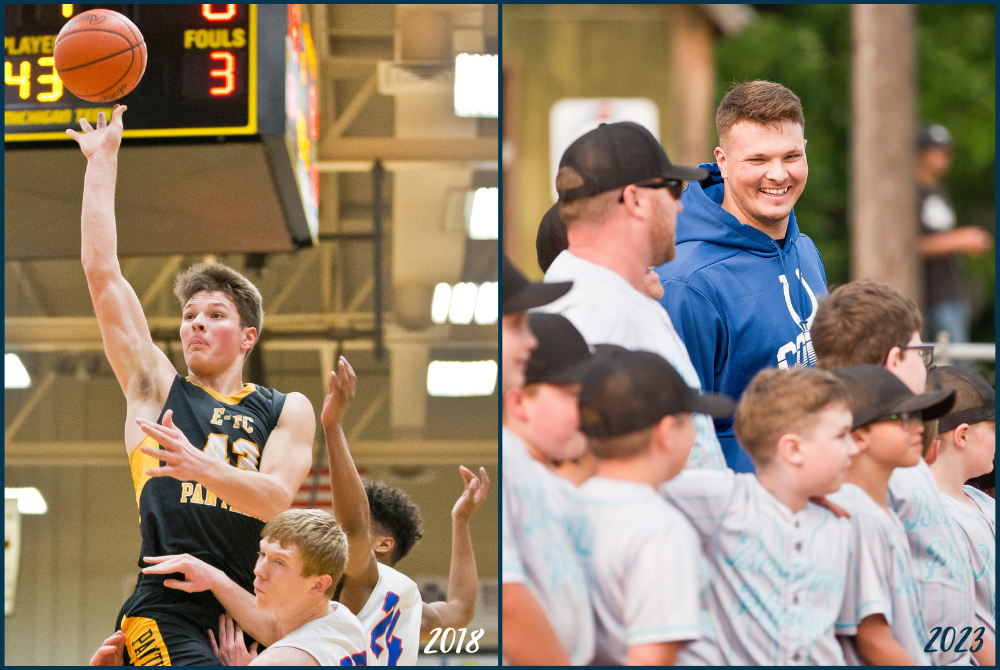
E-TC's Witt Bulldozing Path from Small Town to Football's Biggest Stage
By
Jason Juno
Special for MHSAA.com
June 28, 2024
Ewen-Trout Creek graduate Jake Witt is playing for a spot on the Indianapolis Colts’ 53-man roster. The memories of high school sports, and the impact they’ve had on his journey to the NFL, have stuck with him through his college days and even now as a professional.
 The 300-plus receiving yards he went for in a game against the eventual 8-player state champion back in 2017.
The 300-plus receiving yards he went for in a game against the eventual 8-player state champion back in 2017.
The regular-season basketball game where 3,276 fans turned out to watch his Panthers play just a few months later.
The teamwork prep sports taught him. The family atmosphere he got to be a part of on the high school football team.
“Football was definitely the sport I felt the most family-type feeling with it,” Witt said earlier this week after fishing on Erickson Lake while back in the Upper Peninsula before training camp begins next month. “That’s what drew me back to wanting to play football in college, was my opportunity in high school to play and getting that feeling with the guys and that family-oriented feel.”
Witt played two years of high school football. He lined up exclusively at wide receiver for Ewen-Trout Creek as a junior and then was more of a blocking tight end when E-TC and Ontonagon joined forces as a co-op program when he was a senior.
He ultimately decided to play basketball first in college, at Michigan Tech. But two of his three finalists were football opportunities.
“Obviously playing basketball from second grade on, people would probably assume that I would want to play basketball in college,” Witt said. “I think that just goes to show that football in those two years had a big impact and obviously it led me to where I am when I played at Northern and where I am today.”
Witt played only one year of basketball at Tech. He transferred to Northern Michigan University to attend as a student only before being talked into playing football.
He was initially a tight end there before moving to tackle because of injuries during a game against Ferris State. He dominated, not allowing a sack or even a quarterback pressure against what was considered the best Division II defensive line in the country.
He stayed at tackle for what was left of that season and then all of his final year at Northern. Despite his limited time at the position, he had the attention of NFL scouts and entered the draft. The attention reached a fever pitch during his pro day at Central Michigan when he wowed with his athleticism. His 9.92 Relative Athletic Score, a way to measure players’ athletic testing while accounting for their size, was one of the best for an offensive tackle prospect since it began being used in 1987.
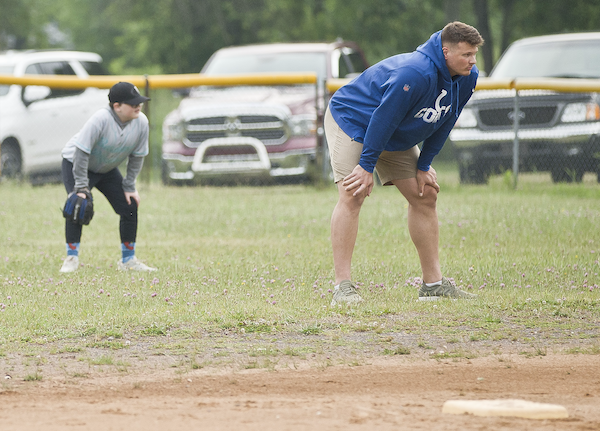 He was drafted with the 236th pick, in the seventh round, by the Colts in 2023.
He was drafted with the 236th pick, in the seventh round, by the Colts in 2023.
His first training camp was cut short due to a hip injury, and he was then placed on season-ending injured reserve. But he’s back healthy and ready to go. He practiced at second-string left tackle during the offseason camp this spring and now hopes to earn a spot on the 53-man roster with training camp set to begin in a month.
“I want to go into training camp, play well and then play well enough to where they can’t release me off the 53,” Witt said. “The next goal is to play in a game. And I think that will start with special teams, that will start with field goal. And then from there, obviously, everybody is one week of great practice away from playing with the offense, one injury away from playing in a game with the offense.”
Those who watched him during his high school days in the U.P. likely wouldn’t be at all surprised to see that happen.
Witt is still the only receiver to go for 300 or more receiving yards in 8-player football in state history, according to the MHSAA record book. And he did it twice, a 325-yard game against Eben Junction Superior Central as a junior and the 305-yard performance against Crystal Falls Forest Park as a senior.
The Ontonagon co-op team had mostly stuck to running the ball that season, but looked for Witt through the air against the eventual state champion Trojans.
“I think it was 345 (yards), I think they sent in the wrong number,” Witt said. “That was one game where we switched things up with our offensive attack and threw the ball a lot more, and it ended up paying off for us very well. We were down big at halftime, and we pushed back and we were in a battle with them in the second half. It was a great game. We didn’t end up winning, but it was a lot of fun.”
He enjoyed both years of high school football – even while mostly blocking on the line as a senior despite having shown previously to be a more-than-capable receiver.
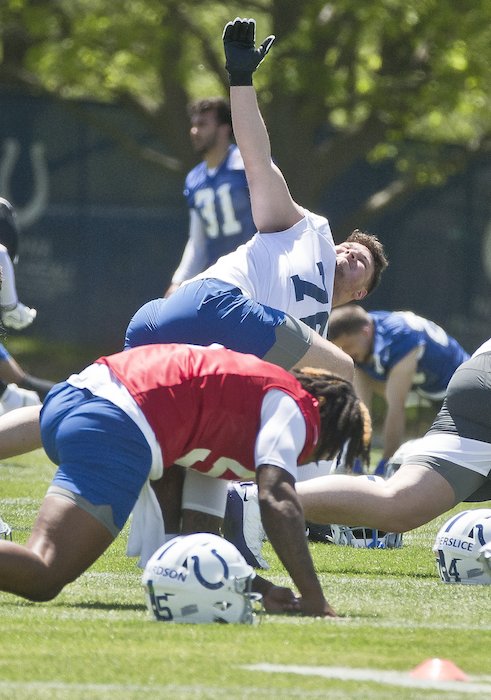 “A lot of the offense wasn’t focused on me anymore, which was great,” Witt said. “It made me a much more well-rounded football player. It made me a much better athlete, it gave me a better perception on things as a football player versus just being a receiver. I think both years were great for different reasons.”
“A lot of the offense wasn’t focused on me anymore, which was great,” Witt said. “It made me a much more well-rounded football player. It made me a much better athlete, it gave me a better perception on things as a football player versus just being a receiver. I think both years were great for different reasons.”
Witt said every sport he played in high school was beneficial to him going forward. Basketball, for example, taught him teamwork and coordination.
“And just relationship building is huge; for me, it helped me move on to the professional football level,” he said.
No high school game was quite as memorable for him as that regular-season basketball game at Michigan Tech on a chilly Wednesday night in Houghton.
Ewen-Trout Creek and Dollar Bay were tied atop the U.P. small-school poll. With that type of matchup, and the chance for fans in the Copper Country to see the 6-7 Witt and his above-the-rim play that’s pretty unique in the U.P., the game was moved from Dollar Bay’s tiny gym to Michigan Tech. (He wasn’t quite 300 pounds like he is now, but he was close – and he came into that game averaging 27 points and 16 rebounds per game with no one able to match his size and strength.)
They expected a crowd; they got 3,276. The latest arriving fans had to sit on the floor on the baseline.
“You don’t see that very much in Division 4 basketball even in the playoffs,” Witt said. “Just having that atmosphere, and especially having it between two of the best U.P. teams at the time, and having the storyline that was behind the game was great – and one of the most memorable events to this day still for me.”
Witt is looking forward to the challenge of training camp and achieving his goals in Indianapolis. But he’s not rushing away a U.P. summer.
He helped out at last week’s U.P. Football All-Star game. He was happy to provide insight for any players headed off to play college ball, and they helped the Marquette County Habitat for Humanity with the finishing touches on one of their houses.
Over the next month, he’ll still be training, going over the playbook and doing position skill work. As happy as he was to help out last week, he’s happy to be on the lake again, too, fishing like a normal Yooper.
“That’s what I’ve been trying to do, that and train,” Witt said. “Just trying to destress before I get back into it.”
PHOTOS (Top) At left, Jake Witt played for Ewen-Trout Creek during a 2018 basketball game at Michigan Tech, and at right Witt takes a photo with area youth baseball players last summer. (Middle) Witt, right, umpires a baseball game last summer. (Below) Witt warms up during the Indianapolis Colts’ rookie camp in May 2023. (Photos by Jason Juno.)

